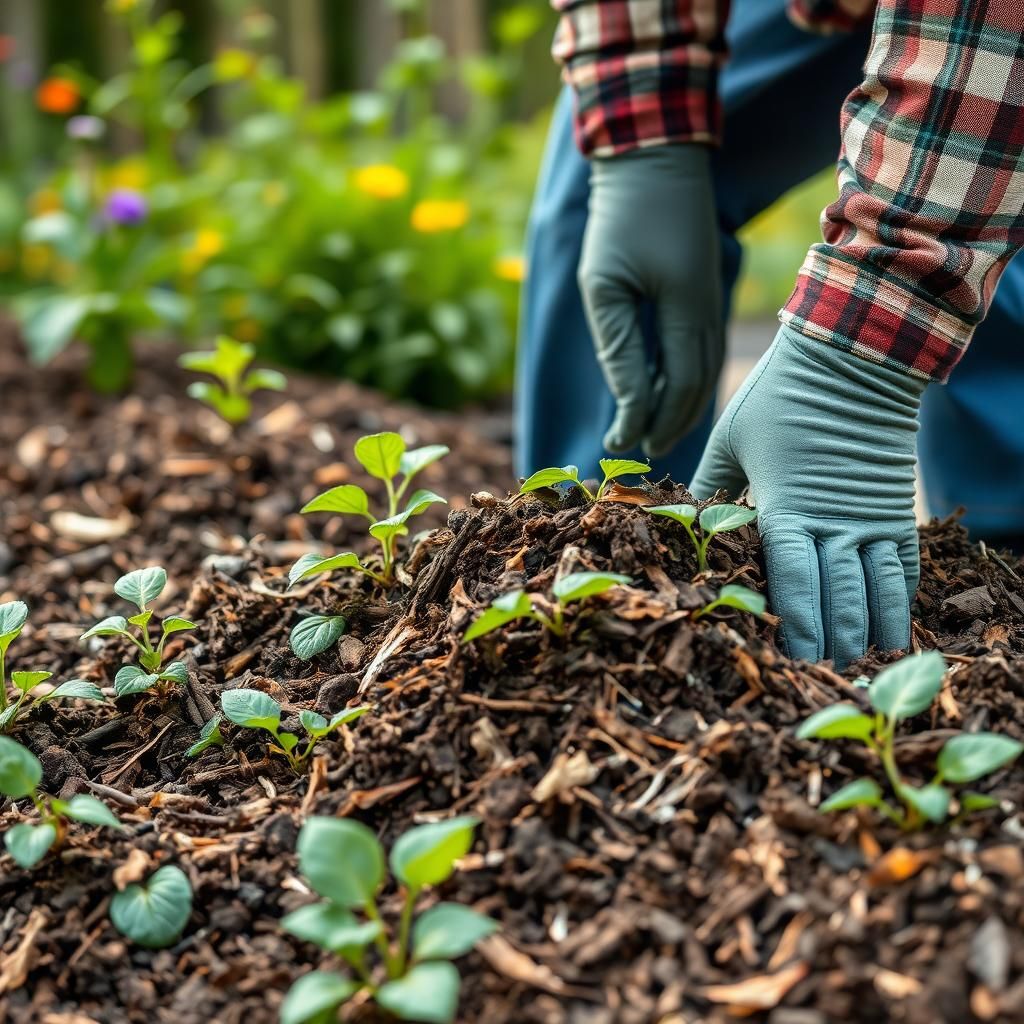Can You Put Mulch on Too Thick? Understanding the Right Depth for Healthy Gardens

Mulch is an essential component for maintaining healthy gardens, providing benefits such as moisture retention, weed suppression, and temperature regulation. However, applying mulch too thickly can lead to a host of problems, including root suffocation and increased pest issues. Understanding the right depth for mulch application is crucial for promoting optimal plant growth and maintaining soil health. In this article, we will explore the ideal thickness for various types of mulch, factors to consider when applying it, and the potential pitfalls of over-mulching. Join us as we delve into the best practices for creating a thriving garden environment.
Can You Put Mulch on Too Thick?
Applying too much mulch can lead to various issues for your garden or landscape. When mulch is laid too thickly, it can create a barrier that blocks water and oxygen from reaching the soil, potentially suffocating the roots of your plants. Moreover, excess mulch can encourage the growth of fungus and other pests, which can hinder the health of your plants rather than promote it. Ideally, a layer of mulch should be between 2 to 4 inches; going beyond this can result in detrimental effects.
Understanding the Ideal Mulch Thickness
The ideal mulch thickness generally depends on the type of plants you have and the specific mulch material used. For most gardens, a thickness of about 2 to 4 inches provides adequate benefits, such as weed suppression and moisture retention. If the layer is any thicker, the risks of suffocation and fungal growth increase significantly, leading to the potential decline in plant health.
Signs of Over-Mulching
There are several signs that indicate you may have applied too much mulch. Key symptoms include visible patches of fungus, a noticeable odor of decomposition, and soil that remains excessively damp, even during dry weather. Additionally, if the lower stems and roots of plants appear to be rotting, it is a strong indicator that the mulch layer is too thick and may need to be reduced.
Benefits of Mulching at the Correct Depth
Properly mulching at the recommended depth can yield numerous benefits for your garden. A suitable layer helps in retaining soil moisture, regulating soil temperature, and preventing the growth of weeds. This not only promotes healthier plant growth but also reduces the amount of water and effort needed for maintenance, making gardening more sustainable and efficient.
How to Correct Over-Mulched Areas
If you find that you've applied too much mulch, it's important to take corrective action to restore the health of your plants. Start by carefully removing the excess mulch with a rake or your hands. Ensure that you leave a nice 2 to 4 inches of mulch depth around the plants, taking care to avoid covering the stem or base of the plants to prevent rot. This practice will help in resuming proper water and air circulation to the roots.
Recommended Mulch Materials
The type of mulch material you choose can also impact the effectiveness of your gardening efforts. Organic materials such as wood chips, straw, and bark not only suppress weeds but also improve soil quality as they decompose. In contrast, inorganic options like gravel or rubber can provide longer-lasting coverage without the risk of excess decomposition, making them suitable for pathways and decorative purposes.
| Mulch Type | Benefits | Ideal Thickness |
|---|---|---|
| Wood Chips | Moisture retention, improves soil | 2-4 inches |
| Straw | Weed suppression, biodegradable | 2-4 inches |
| Bark | Long-lasting, aesthetic appeal | 2-4 inches |
| Gravel | Durability, low maintenance | 1-2 inches |
| Rubber | Longevity, no decomposition | 1-2 inches |
What happens if mulch is too thick?

If mulch is too thick, several issues can arise that can negatively affect plant health, soil quality, and garden aesthetics. Here are some consequences of applying mulch too thickly:
1. Oxygen Deprivation: Excessive mulch can create a barrier that restricts the flow of air to the soil. Plants need oxygen for their roots to function properly, and too much mulch can suffocate their root systems.
2. Water Retention Issues: While mulch is meant to help retain moisture, a thick layer can also trap too much water in the soil. This can create soggy conditions that are detrimental to plant roots, leading to root rot and other fungal diseases.
3. Nutrient Deficiency: Overly thick mulch can harbor pests and diseases, and it may slow down the decomposition process of organic mulch. This can result in a nutrient-poor environment for plants, as vital nutrients may not be released into the soil effectively.
See also:
4. Difficulties in Maintenance: Thick mulch can complicate garden maintenance tasks such as weeding, watering, and fertilizing. It can make it harder to apply additional treatments or amendments to the soil, inhibiting proper plant care.
5. Attraction of Pests: An overly dense layer of mulch can create a perfect habitat for insects and rodents. These pests may take advantage of the shelter and moisture provided by the thick mulch, leading to potential infestations that can harm plants.
Oxygen Deprivation in Soil
When mulch is applied too thickly, it can result in reduced oxygen levels in the soil. This is primarily due to the physical barrier it creates between the atmosphere and the soil. Roots require oxygen for cellular respiration, and without adequate oxygen, plants may exhibit stunted growth or even die.
- Roots unable to absorb nutrients effectively.
- Increased susceptibility to diseases.
- Overall poor plant performance.
Water Retention and Drainage Issues
While the purpose of mulch is to help retain moisture, too much of it can lead to poor drainage. Water may pool at the surface and saturate the roots, causing plants to suffer from root rot and other water-related diseases.
- Excessive moisture leading to root diseases.
- Difficulty in assessing soil moisture needs.
- Possible drowning of more sensitive plant species.
Nutrient Deficiency and Soil Health
Thick mulch layers may inhibit the breakdown of organic materials within the mulch itself, preventing the release of essential nutrients into the soil. This lack of nutrients can hinder plant growth and overall health.
- Insufficient nutrition uptake by plants.
- Weaker plant structures and less robust blooms.
- Possible yellowing of leaves due to nutritional deficiencies.
Gardening Maintenance Challenges
Managing a garden with substantial mulch becomes more challenging. Maintenance tasks such as watering and fertilizing require more effort when the mulch obstructs access to the soil.
- Trouble identifying and removing weeds.
- Complicated application of fertilizers or amendments.
- Increased physical labor needed for upkeep.
Pest Attraction and Infestation Risks
A dense mulch layer can create a moist environment that is attractive to various pests, including insects and small mammals. These pests may thrive in the sheltered conditions, potentially leading to infestations that compromise plant health.
- Increased likelihood of pests residing and reproducing.
- Plant damage from hungry animals or insects.
- Higher need for pest management strategies.
How thick can you put mulch?

Mulch is an essential component in gardening and landscaping, providing benefits such as moisture retention, weed suppression, and temperature regulation for the soil. The thickness of mulch you can apply depends on several factors, including the type of mulch, the purpose of its use, and the specific needs of the plants involved. Generally, a layer of mulch should be applied at a thickness of 2 to 4 inches.
However, if you are using herbaceous or softer materials like shredded leaves or grass clippings, you may want to stay closer to 2 inches to avoid matting, which can impede water infiltration. For decorative purposes or when using heavier wood chips or bark, you can opt for a thicker layer of up to 4 inches, but be cautious not to pile mulch against tree trunks or plant stems, as this can lead to decay and attract pests.
Benefits of Mulch Thickness
Mulch thickness can have significant impacts on the health of your garden. Here are some benefits to consider:
- Weed Control: A thicker layer of mulch can effectively suppress weed growth by blocking sunlight.
- Moisture Retention: A proper thickness helps keep moisture in the soil, reducing the need for frequent watering.
- Soil Temperature Regulation: Mulch insulates the soil, keeping it cooler in summer and warmer in winter.
Types of Mulch and Their Recommended Thickness
Different types of mulch have varying thickness recommendations based on their material properties. Here’s a breakdown:
See also:
- Wood Chips: Typically, a 3 to 4-inch layer is recommended for effective moisture retention and weed suppression.
- Bark Mulch: A thickness of 2 to 3 inches is usually ideal, providing good coverage without suffocating plants.
- Grass Clippings: A thinner layer of 1 to 2 inches is preferred to prevent matting and allow water to reach the soil.
Common Mistakes When Applying Mulch
Applying mulch incorrectly can lead to problems in your garden. Here are some common mistakes:
- Over-mulching: Applying too thick a layer can suffocate plant roots and promote rot.
- Inadequate Spacing: Mulch should not touch the stems or trunks of plants to prevent decay and pest attraction.
- Using Inappropriate Materials: Some mulches can lead to nitrogen depletion in the soil; be cautious about what you use.
Adjusting Mulch Thickness for Different Seasons
You may need to adjust the thickness of your mulch with changing seasons to optimize benefits:
- Spring: Apply a layer of mulch to help retain moisture as the weather warms up.
- Summer: Consider adding mulch to maintain cooler soil temperatures and reduce evaporation.
- Fall: Add a thicker layer to protect the roots from winter temperatures.
Considerations for Specific Plants
Different plants have varied requirements for mulch thickness. Here are some considerations:
- Perennials: Generally benefit from 2 to 3 inches of mulch to help with moisture and soil temperature.
- Trees: A 2 to 4-inch layer around the base can be beneficial but should not touch the trunk.
- Annuals: A lighter layer of 1 to 2 inches is advisable to avoid overwhelming young plants.
Is it possible to put down too much mulch?

Yes, it is indeed possible to put down too much mulch, and doing so can have several negative impacts on your garden or landscaping. Mulch serves various purposes: it helps retain soil moisture, suppresses weeds, and adds organic matter to the soil as it decomposes. However, excessive mulch can lead to problems such as inadequate oxygen supply to the soil, root rot, and pest issues. It is essential to apply mulch adequately to optimize its benefits while minimizing potential downsides.
Effects of Too Much Mulch on Soil Health
Over-mulching can significantly affect the health of the soil beneath it. Soil requires oxygen to support plant growth, and too much mulch can restrict airflow, leading to anaerobic conditions. This can result in:
- Decomposition Issues: Excessive mulch layers may decompose too slowly, leading to the accumulation of toxic substances.
- Soil Compaction: Heavily packed mulch can compress soil, complicating root growth and water drainage.
- pH Imbalance: Over time, an excess in certain mulches, especially wood chips, can affect soil pH, making it less suitable for various plants.
Signs of Over-Mulching
Identifying the signs of over-mulching can help you take corrective action before major issues arise. Common indicators include:
- Plant Stress: Yellowing leaves or stunted growth may indicate that roots are not getting enough oxygen.
- Pest Infestation: A thick layer of mulch can create a habitat for pests, such as termites or rodents.
- Soil Moisture Problems: If the soil remains consistently overly wet, it might be an indication of excess mulch trapping moisture.
Recommended Mulch Depths
It’s crucial to follow proper guidelines regarding mulch depth to prevent over-application. Recommended depths generally include:
- 2 to 4 Inches: For most landscape beds and shrub borders, a layer of 2 to 4 inches is typically ideal.
- 1 to 2 Inches: Use this for sensitive plants or where soil needs more exposure to air.
- 0 to 1 Inch: This minimal application can work for garden pathways where you want to reduce weeds without suffocating the soil.
Correcting Over-Mulched Areas
If you discover an area has been over-mulched, it's important to take steps to rectify the situation. You can:
- Remove Excess Mulch: Carefully clear away the top layer to allow for better airflow to the soil.
- Aerate the Soil: After removing excess mulch, aeration can help rejuvenate the soil beneath.
- Monitor Plant Responses: Keep a close eye on plants after making adjustments to ensure they begin to recover.
Choosing the Right Type of Mulch
Not all mulches are created equal, and using the right type can help mitigate the effects of over-mulching. Consider the following:
- Organic Mulch: Materials like bark, straw, or shredded leaves provide nutrients as they decompose but can lead to problems if over-applied.
- Inorganic Mulch: Options like gravel or landscaping fabric are less prone to decomposition and can help control weeds without affecting soil health negatively.
- Avoiding Non-Biodegradable Mulch: Plastics or rubber mulches do not break down and can cause serious drainage and root issues.
Questions from Our Readers
Can you put mulch on too thick?
Yes, applying mulch too thick can cause issues such as suffocating plants and preventing water from reaching the soil. A layer that is too thick may also encourage pests and create a habitat for diseases.
What is the recommended thickness for mulch?
The ideal thickness for mulch is generally between 2 to 4 inches. This range allows for adequate moisture retention while still promoting good air circulation around the plant roots.
See also:
What happens if mulch is too thick?
If mulch is applied too thickly, it can lead to root rot due to excessive moisture retention and create a barrier that hinders essential nutrients from reaching the plants. This can ultimately result in poor plant health and stunted growth.
How can you fix mulch that is too thick?
To correct mulch that is too thick, you can remove excess mulch by raking it away from the base of plants and spreading it out to achieve the recommended thickness. This ensures that plants receive adequate air and water to thrive.

If you want to read more articles like Can You Put Mulch on Too Thick? Understanding the Right Depth for Healthy Gardens, we recommend you check out our Mulch category.
Leave a Reply
Related Articles